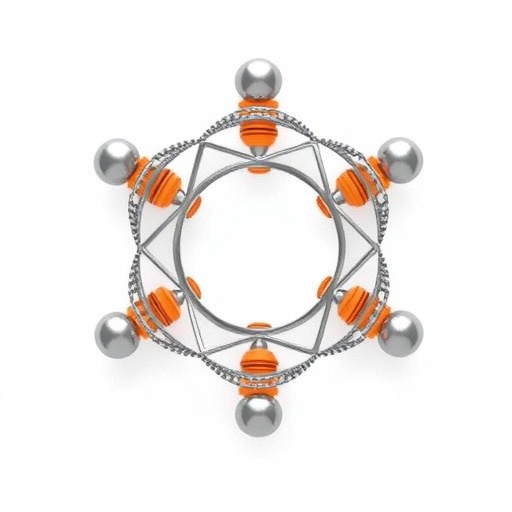A groundbreaking study published recently in National Science Review unveils a remarkable advancement in the field of spintronics by demonstrating efficient spin-orbit torque (SOT) induced magnetization switching within the intrinsic magnetic topological insulator MnSb₂Te₄. This research, led by Dr. Zihan Li and co-first author Sheng Pan, alongside their colleagues Professors Faxian Xiu and Jiexiang Yu, pioneers a new direction for utilizing intrinsic magnetic topological materials in state-of-the-art spintronic devices that could revolutionize data storage technologies.
The quest for faster and more efficient data storage drives intense research into novel magnetic materials enabling lower power consumption and higher switching speeds. Spin-orbit torques provide an attractive mechanism for electric control of magnetization, promising breakthroughs in both theoretical understanding and practical device engineering. Conventional SOT systems, however, often rely on heterostructures involving heavy metals with large spin-orbit coupling or interfaces with broken inversion symmetry. These structures typically face challenges balancing high spin-charge conversion efficiency with structural simplicity, stability, and reproducibility.
MnSb₂Te₄, an intrinsic magnetic topological insulator, embodies a unique combination of magnetic order and nontrivial topological surface states, leading to highly efficient spin-charge conversion rooted in spin-momentum locking. The research team employed first-principles calculations to explore electronic properties, focusing on the Hall conductivities characteristic of different spin configurations. Remarkably, while the anomalous Hall conductivity remains essentially null within the band gap—owing to symmetries governing Berry curvature contributions—the spin Hall conductivity maintains a robust magnitude independent of spin orientation. This behavior stems from asymmetric topological surface states sustaining persistent spin currents, marking a departure from typical systems dominated by bulk contributions.
To validate theoretical predictions, the team synthesized high-quality MnSb₂Te₄ thin films through molecular beam epitaxy (MBE), ensuring uniform crystalline quality and magnetic properties suitable for spintronic experiments. Magnetization measurements confirmed ferromagnetic ordering with an out-of-plane anisotropy—a prerequisite for deterministic magnetization switching. Current-induced switching experiments conducted under a modest external magnetic field of -0.2 T revealed clear hysteresis loops in anomalous Hall resistance, with two robust magnetic states reproducibly maintained at zero applied current. These results definitively demonstrate that a single layer of MnSb₂Te₄ can exhibit spin-orbit torque-induced magnetization reversal.
Further studies investigated the temperature and magnetic field dependence of the switching phenomena. At a cryogenic 10 K, the application of positive and negative external magnetic fields produced opposite polarity loops in anomalous Hall resistance, indicative of reversible spin textures. Increasing temperature caused a gradual decrease in both the magnitude of anomalous Hall resistance and the switching current, correlating with the reduction in overall magnetization. Such temperature sensitivity highlights the interplay between thermal fluctuations and magnetic anisotropy, while confirming that in-plane magnetic fields and DC currents offer independent control over the stable magnetization states in the MnSb₂Te₄ system.
Quantitative characterization of the spin-orbit torque efficiency was pursued using harmonic Hall effect measurements. An alternating current generates a periodic effective magnetic field, compelling the magnetization vector to oscillate near its equilibrium until producing a measurable second harmonic resistance signal. By analyzing this signal, the team extracted the spin Hall angle, a central figure of merit describing the effectiveness of spin current generation from charge currents. The experimentally derived spin Hall angle of approximately 41 at 6 K far surpasses values typical of conventional heavy metal/ferromagnet SOT systems, indicating a highly efficient intrinsic spin conversion mechanism present in MnSb₂Te₄.
To overcome the practical limitation of needing external magnetic fields during switching, the researchers engineered heterostructures combining MnSb₂Te₄ with FeTe₀.₉ layers. The proximity of ferromagnetic and antiferromagnetic phases introduced exchange bias fields capable of modulating the effective internal magnetic environment. This exchange bias underpins field-free magnetization switching—a critical milestone for device integration, enhancing energy efficiency and usability. Experimental observations confirmed the presence of this exchange bias and successful demonstration of spin-orbit torque switching in zero applied magnetic fields.
The implications of these findings extend beyond academic interest, offering new opportunities for compact, low-power spintronic devices incorporating single layers of intrinsic magnetic topological insulators without auxiliary spin source layers. The exceptionally high spin Hall angle suggests fundamental spin transport mechanisms distinct from conventional materials, potentially enabling ultrafast switching operations and improved thermal stability. Additionally, the ability to engineer field-free switching widens the technological applicability, making the material system highly attractive for next-generation magnetic random-access memory (MRAM) and logic applications.
By integrating theoretical insights with meticulous experimental validation, the study provides compelling evidence positioning MnSb₂Te₄ as a versatile platform for spintronics. The combination of robust ferromagnetism, topological surface state-induced spin currents, and sizable spin-orbit torque efficiency underpins novel paradigms for magnetization control. This work not only enriches the fundamental understanding of spin dynamics in magnetic topological materials but also charts a promising path for translating these exotic properties into device realities.
As the demand for faster, denser, and more energy-efficient storage continues to escalate, innovation hinges on discovering materials capable of transcending the limitations of classical spintronic approaches. This research exemplifies how leveraging the intrinsic properties of topological magnets like MnSb₂Te₄ can meet such challenges, promising advancements in computing technologies rooted in the quantum mechanical interplay of spin, charge, and topology.
In conclusion, the demonstrated spin-orbit torque switching in a single MnSb₂Te₄ layer, facilitated by its asymmetric topological surface states and reinforced by exchange bias engineering, marks a pivotal advance in the spintronics landscape. The large spin Hall angle and capacity for field-free operation underscore the material’s suitability for future memory and logic applications, bridging fundamental physics and technological innovation toward real-world impact.
Subject of Research: Spin-orbit torque-induced magnetization switching in the intrinsic magnetic topological insulator MnSb₂Te₄
Article Title: (Not explicitly provided in the content)
News Publication Date: (Not specified)
Web References: http://dx.doi.org/10.1093/nsr/nwaf178
References: (Not provided)
Image Credits: ©Science China Press
Keywords: spin-orbit torque, magnetic topological insulator, MnSb₂Te₄, magnetization switching, spin Hall conductivity, spin Hall angle, molecular beam epitaxy, exchange bias, spintronics, harmonic Hall effect, field-free switching, topological surface states




